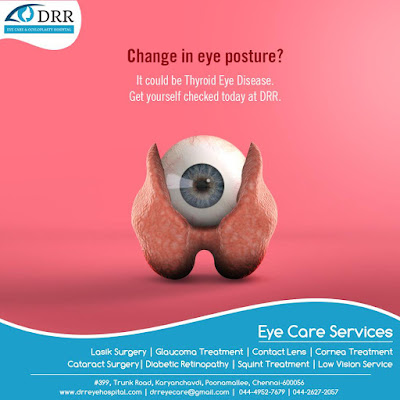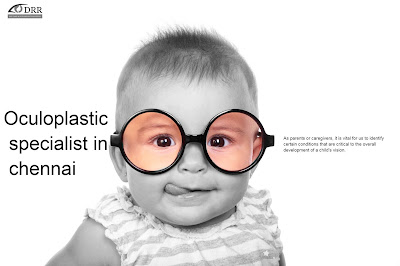 |
| Thyroid eye disease surgery hospital in chennai |
Thyroid Eye Disease or TED is a condition wherein the eyes are affected due to abnormal thyroid hormone level in the body. Very rarely this condition can occur in the presence of normal blood thyroid levels. In TED the tissues at the back of the eyes and around the eye; become swollen. This makes the eye look bulgy and gives a staring appearance. This condition is popularly termed as the Grave’s disease or the Grave’s Ophthalmopathy. TED is more common in people with hyperactive thyroid disorder. These people tend to sweat more, have uneven heartbeat, unstable blood pressure coupled with fatigue and weight loss. On research, experts have found that thyroid eye disease is an autoimmune condition where the thyroid gland is affected by immune cells which disrupt the regulatory mechanism and there is uninhibited secretion of thyroid hormone by the thyroid gland. When the tissues of the eyes are affected by the antibodies, the eyes get red and swollen.
Although risk is low, 10% people with TED can have decrease in vision or loss of vision.
Common Symptoms of TED
- Swelling of eyelids more in mornings and in sunlight
- Redness, discomfort and watering
- Double vision especially on prolonged reading
- Inability to completely close the eyes
- Decrease or blurring of vision noticed especially when one eye is closed.
Treatment
Thyroid Eye disease is diagnosed by symptoms and eye examination along with blood tests. An eye scan may also be advised depending upon the patient’s condition. The treatment might differ from person to person depending upon their symptoms and vulnerability. It is also a fact that curing or stabilizing thyroid levels in the body may not stop the eye condition from aggravating. Treatment for thyroid eye disease should be undertaken simultaneously but independently. Your ophthalmologist will advise you on steps to be taken for treating Grave’s eye Disease.
Thyroid Eye Disease should be treated on time. If delayed, the complications could extend the recovery time making it uncomfortable for the patient to do his/her daily activities. Once the active stage is over, the residual bulgy eye or squint or lid swelling needs surgical correction. These will not resolve on their own unlike the common belief that bulgy eyes resolve on its own. Normal appearance of the eyes can be restored by minimally invasive advanced keyhole surgeries.
Simple Steps to be taken along with treatment, if diagnosed with TED
- Head elevation while sleeping
- Use sun glasses in sunlight
- Quit smoking
- Diabetes control
- Daily vision checks at home by closing one eye at a time so that decreased vision in one eye can be detected early.
- Look for colour desaturation at home while watching TV by closing one eye.
This Content was Originally Published by DRR Eye Care and Oculoplasty Hospital (http://www.drreyehospital.com) has been making a mark with advanced and sophisticated infrastructure and facilities. Our esteemed team ensures that patients get the best treatment and care. We educate patients about the treatment they are offered. Visit DRR Eye Care and Oculoplasty Hospital in Karayanchavadi, Chennai for best treatment city.

